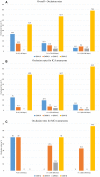Use of a p64 MW Flow Diverter with Hydrophilic Polymer Coating (HPC) and Prasugrel Single Antiplatelet Therapy for the Treatment of Unruptured Anterior Circulation Aneurysms: Safety Data and Short-term Occlusion Rates
- PMID: 35562486
- PMCID: PMC9458553
- DOI: 10.1007/s00270-022-03153-8
Use of a p64 MW Flow Diverter with Hydrophilic Polymer Coating (HPC) and Prasugrel Single Antiplatelet Therapy for the Treatment of Unruptured Anterior Circulation Aneurysms: Safety Data and Short-term Occlusion Rates
Abstract
Purpose: To assess the safety and short-term occlusion rates in procedures using the p64 MW hydrophilic polymer-coated (HPC) flow diverter (FD) with prasugrel single antiplatelet therapy (SAPT) for the treatment of anterior circulation saccular aneurysms.
Methods: We retrospectively identified patients who underwent treatment of one or more intracranial anterior circulation saccular aneurysms between March 2020 and December 2021 with a p64 MW HPC FD and prasugrel SAPT with verified P2Y12 platelet receptor inhibition. Patients diagnosed with fusiform, dissecting, or recently ruptured aneurysms were excluded. Periprocedural and postprocedural complications, clinical outcomes, and angiographic follow-up results were evaluated.
Results: One hundred and two patients with 132 intracranial aneurysms met the inclusion criteria. Previous or concomitant treatments (e.g., coil occlusion) had been performed on 18 of these aneurysms. The technical success rate (i.e., implantation of the intended FD) was 100% with an average of 1.1 devices implanted per patient. Periprocedural and postprocedural complications occurred in 13.6% and 6.8% of these patients, respectively. No mortality or permanent clinical deterioration (i.e., modified Rankin scale score ≥ 3) were reported. Early follow-up digital subtraction angiography revealed aneurysmal occlusion rates of 72.6% and 83.8% at four and nine months, respectively.
Conclusions: The implantation of a p64 MW HPC FD with prasugrel SAPT is safe and results in rapid, reliable and effective aneurysmal occlusion.
Keywords: Aneurysm; Anti-thrombogenic coating; Flow diverter; Prasugrel; Single antiplatelet therapy.
© 2022. The Author(s).
Conflict of interest statement
VH has a consultancy agreement with the BALT Group; EH has a consulting agreement with phenox GmbH; HH is co-founder and shareholder of phenox GmbH; all other authors report no conflict of interest.
Figures



References
-
- Skukalek SL, Winkler AM, Kang J, Dion JE, Cawley CM, Webb A, Dannenbaum MJ, Schuette AJ, Asbury B, Tong FC. Effect of antiplatelet therapy and platelet function testing on hemorrhagic and thrombotic complications in patients with cerebral aneurysms treated with the pipeline embolization device: a review and meta-analysis. J Neurointerv Surg. 2016;8:58–65. doi: 10.1136/neurintsurg-2014-011145. - DOI - PubMed
-
- Aguilar-Perez M, Hellstern V, AlMatter M, Wendl C, Bäzner H, Ganslandt O, Henkes H. The p48 flow modulation device with hydrophilic polymer coating (HPC) for the treatment of acutely ruptured aneurysms: early clinical experience using single antiplatelet therapy. Cardiovasc Intervent Radiol. 2020;43:740–748. doi: 10.1007/s00270-020-02418-4. - DOI - PMC - PubMed
MeSH terms
Substances
LinkOut - more resources
Full Text Sources
Medical
Miscellaneous

